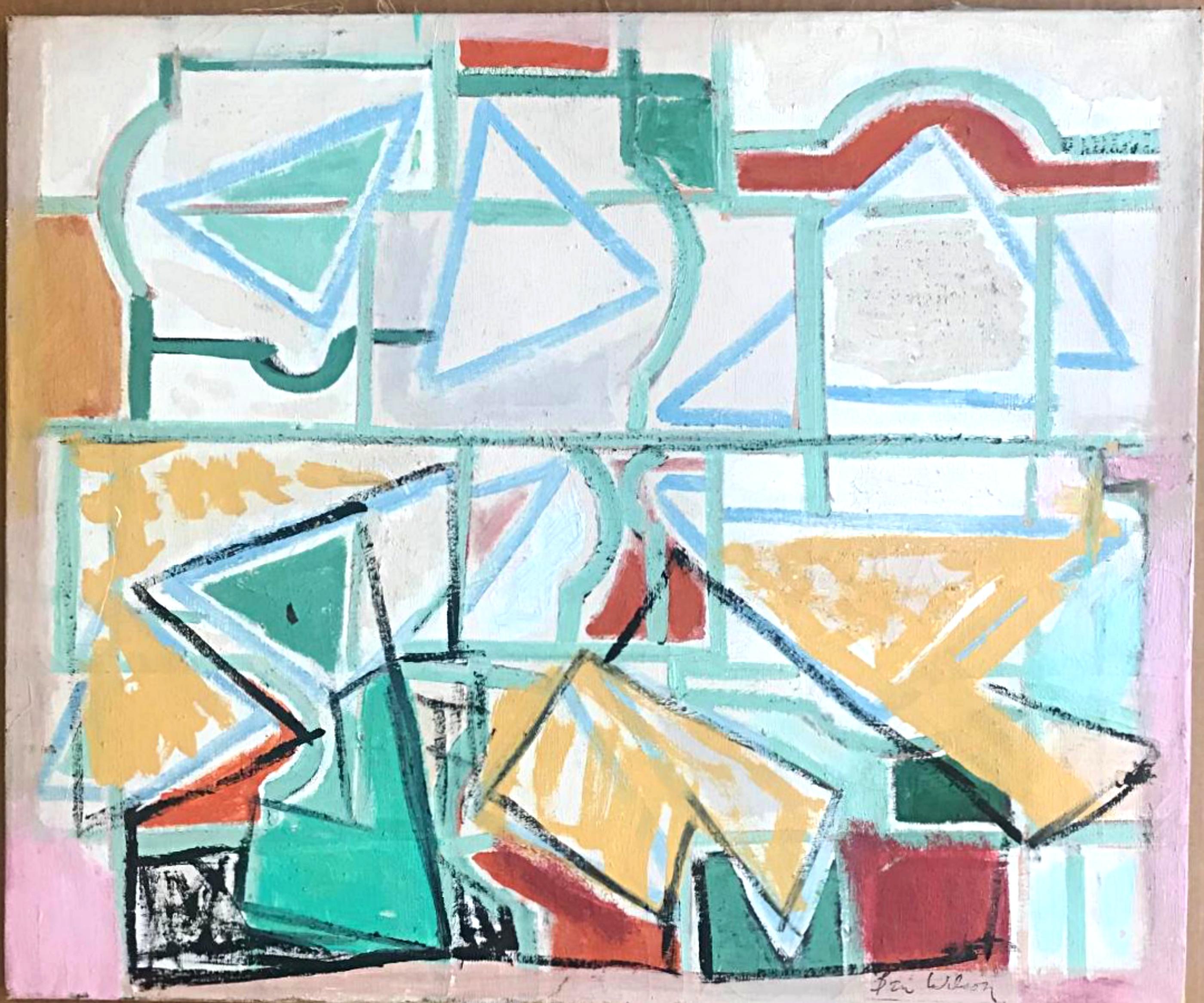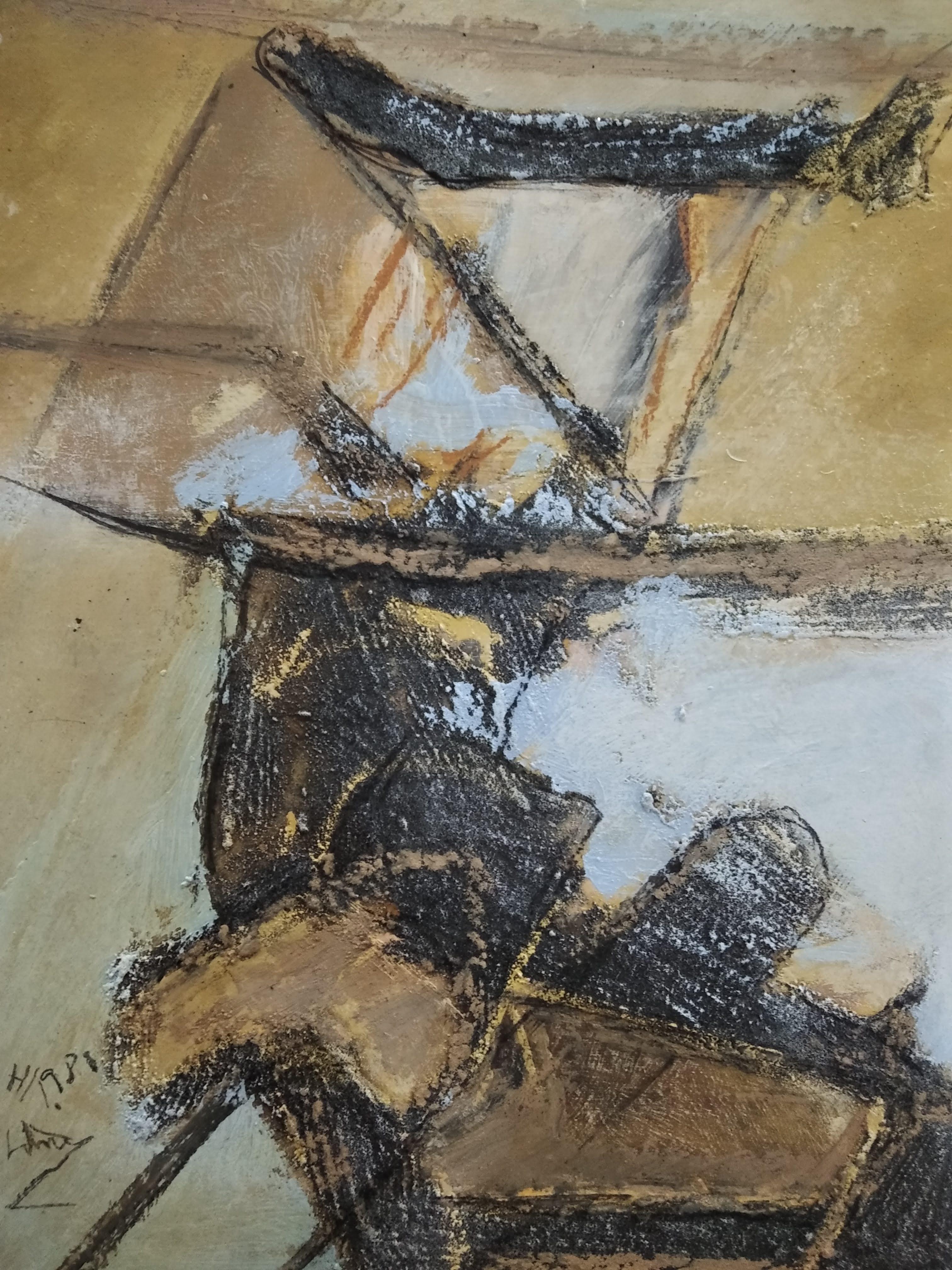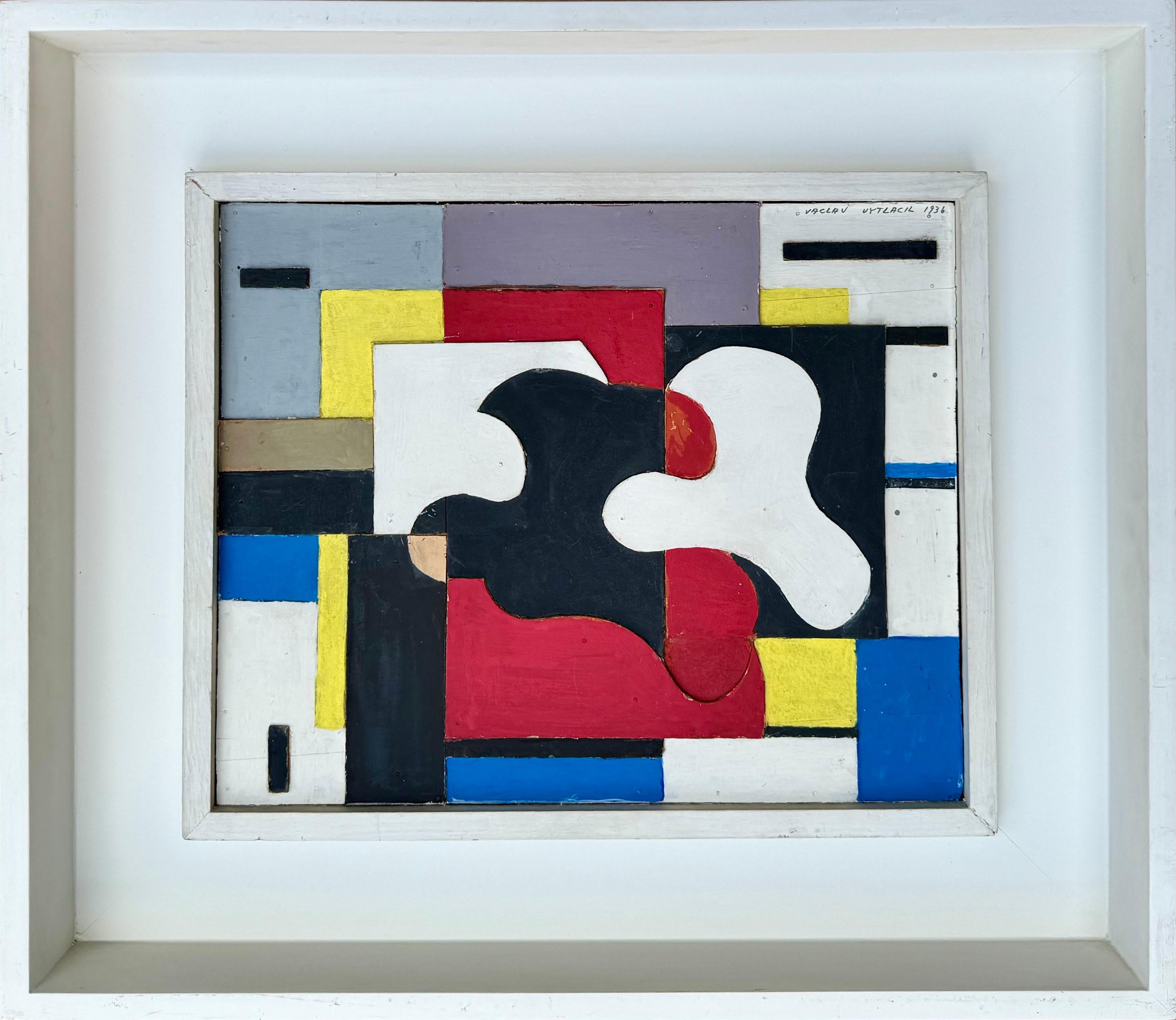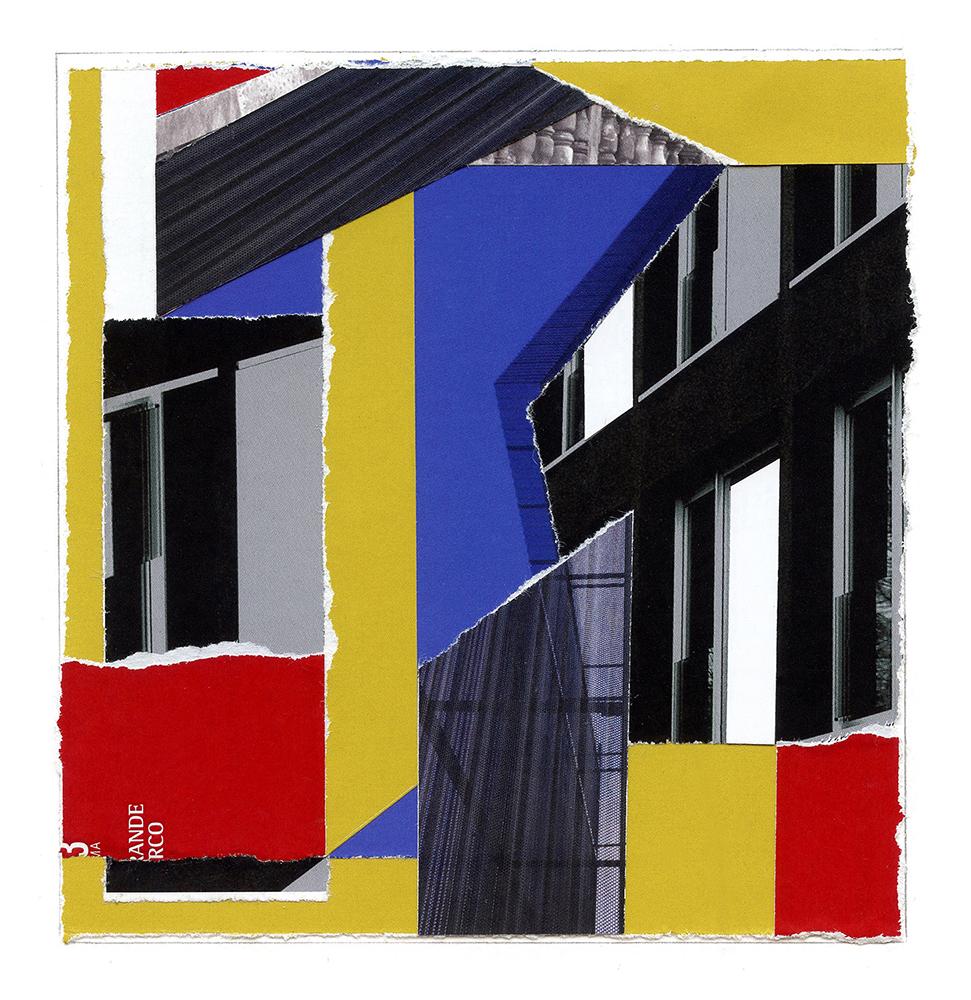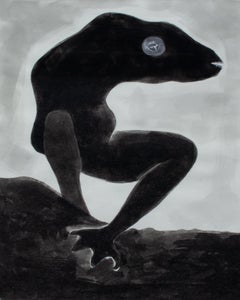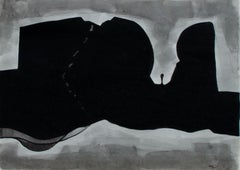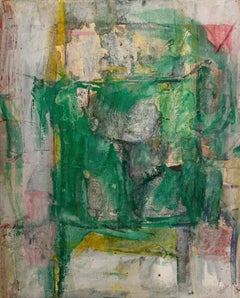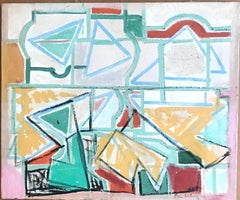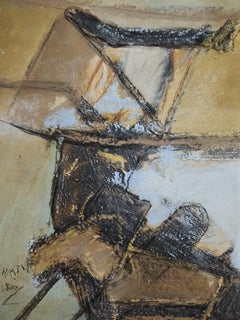Items Similar to "Lumen" Rudolf Baranik, 1975 Political Abstract Imagery Collage Composition
Want more images or videos?
Request additional images or videos from the seller
1 of 4
Rudolf Baranik"Lumen" Rudolf Baranik, 1975 Political Abstract Imagery Collage Composition1975
1975
About the Item
Rudolf Baranik
Lumen, 1975
Signed, titled, dated on the reverse
Collage on board
36 1/2 x 42 inches
Born in Lithuania, he immigrated to the United States in 1938, when his family sent him to live with a relative in Chicago. His parents were secular Jewish socialists and were killed by the Nazis during the Second World War. Baranik was well known in the art world for his political advocacy, and was one of the first artists to organize protests against the war in Vietnam. Some of his best known works are the Napalm Elegies, a series of 30 antiwar paintings created between 1967 and 1974. His art was inspired by his sense of the gross inequities around the world, and he led virtually every progressive political movement within the New York art world from the 1960s to the mid-1990s. Significant exhibitions and awards include:1981 Guggenheim Fellowship in Fine Arts, 1982 "Art Couples 1: May Stevens and Rudolf Baranik," P.S. 1, New York, NY, and 1966 Peace Tower. Baranik's art is included in many collections, including the Museum of Modern Art in New York, the Whitney Museum of American Art and the Hirshhorn Museum.
Baranik died in Eldorado, New Mexico in 1998.
The paintings of Rudolf Baranik are increasingly thought to be among the most important works of the New York School painting of the 1960s and 1970s, with the late paintings in particular considered by American art critic, Donald Kuspit, "the true climax of fifty years of Western abstract painting."
- Creator:Rudolf Baranik (1920 - 1998, Lithuanian)
- Creation Year:1975
- Dimensions:Height: 36.5 in (92.71 cm)Width: 42 in (106.68 cm)
- More Editions & Sizes:Unique WorkPrice: $25,000
- Medium:
- Movement & Style:
- Period:
- Condition:
- Gallery Location:New York, NY
- Reference Number:1stDibs: LU1841215579362
About the Seller
5.0
Gold Seller
Premium sellers maintaining a 4.3+ rating and 24-hour response times
Established in 2022
1stDibs seller since 2022
98 sales on 1stDibs
Typical response time: <1 hour
- ShippingRetrieving quote...Shipping from: New York, NY
- Return Policy
Authenticity Guarantee
In the unlikely event there’s an issue with an item’s authenticity, contact us within 1 year for a full refund. DetailsMoney-Back Guarantee
If your item is not as described, is damaged in transit, or does not arrive, contact us within 7 days for a full refund. Details24-Hour Cancellation
You have a 24-hour grace period in which to reconsider your purchase, with no questions asked.Vetted Professional Sellers
Our world-class sellers must adhere to strict standards for service and quality, maintaining the integrity of our listings.Price-Match Guarantee
If you find that a seller listed the same item for a lower price elsewhere, we’ll match it.Trusted Global Delivery
Our best-in-class carrier network provides specialized shipping options worldwide, including custom delivery.More From This Seller
View All"Cronus Waiting" David Hare, Black and White Surrealist Composition
By David Hare
Located in New York, NY
David Hare
Cronus Waiting, 1990
Ink and Wash on Paper on Board
34 x 25 1/4 inches
“Freedom is what we want,” David Hare boldly stated in 1965, but then he added the caveat, “and what we are most afraid of.” No one could accuse David Hare of possessing such fear. Blithely unconcerned with the critics’ judgments, Hare flitted through most of the major art developments of the mid-twentieth century in the United States. He changed mediums several times; just when his fame as a sculptor had reached its apogee about 1960, he switched over to painting. Yet he remained attached to surrealism long after it had fallen out of official favor. “I can’t change what I do in order to fit what would make me popular,” he said. “Not because of moral reasons, but just because I can’t do it; I’m not interested in it.”
Hare was born in New York City in 1917; his family was both wealthy and familiar with the world of modern art. Meredith (1870-1932), his father, was a prominent corporate attorney. His mother, Elizabeth Sage Goodwin (1878-1948) was an art collector, a financial backer of the 1913 Armory Show, and a friend of artists such as Constantin Brancusi, Walt Kuhn, and Marcel Duchamp.
In the 1920s, the entire family moved to Santa Fe, New Mexico and later to Colorado Springs, in the hope that the change in altitude and climate would help to heal Meredith’s tuberculosis. In Colorado Springs, Elizabeth founded the Fountain Valley School where David attended high school after his father died in 1932. In the western United States, Hare developed a fascination for kachina dolls and other aspects of Native American culture that would become a recurring source of inspiration in his career.
After high school, Hare briefly attended Bard College (1936-37) in Annandale-on-Hudson. At a loss as to what to do next, he parlayed his mother’s contacts into opening a commercial photography studio and began dabbling in color photography, still a rarity at the time [Kodachrome was introduced in 1935]. At age 22, Hare had his first solo exhibition at Walker Gallery in New York City; his 30 color photographs included one of President Franklin Roosevelt.
As a photographer, Hare experimented with an automatist technique called “heatage” (or “melted negatives”) in which he heated the negative in order to distort the image. Hare described them as “antagonisms of matter.” The final products were usually abstractions tending towards surrealism and similar to processes used by Man Ray, Raoul Ubac, and Wolfgang Paalen.
In 1940, Hare moved to Roxbury, CT, where he fraternized with neighboring artists such as Alexander Calder and Arshile Gorky, as well as Yves Tanguy who was married to Hare’s cousin Kay Sage, and the art dealer Julian Levy. The same year, Hare received a commission from the American Museum of Natural History to document the Pueblo Indians. He traveled to Santa Fe and, for several months, he took portrait photographs of members of the Hopi, Navajo, and Zuni tribes that were published in book form in 1941.
World War II turned Hare’s life upside down. He became a conduit in the exchange of artistic and intellectual ideas between U.S. artists and the surrealist émigrés fleeing Europe. In 1942, Hare befriended Andre Breton, the principal theorist of surrealism. When Breton wanted to publish a magazine to promote the movement in the United States, he could not serve as an editor because he was a foreign national. Instead, Breton selected Hare to edit the journal, entitled VVV [shorth for “Victory, Victory, Victory”], which ran for four issues (the second and third issues were printed as a single volume) from June 1942 to February 1944. Each edition of VVV focused on “poetry, plastic arts, anthropology, sociology, (and) psychology,” and was extensively illustrated by surrealist artists including Giorgio de Chirico, Roberto Matta, and Yves Tanguy; Max Ernst and Marcel Duchamp served as editorial advisors.
At the suggestion of Jacqueline Lamba...
Category
1990s Abstract Mixed Media
Materials
Paper, Ink, Board
"Cronus Asleep in the Cave" David Hare, Surrealist Mythological Allegory
By David Hare
Located in New York, NY
David Hare
Cronus Asleep in the Cave, 1991
Acrylic on paper on board
26 X 34 1/4 inches
“Freedom is what we want,” David Hare boldly stated in 1965, but then he added the caveat, “and what we are most afraid of.” No one could accuse David Hare of possessing such fear. Blithely unconcerned with the critics’ judgments, Hare flitted through most of the major art developments of the mid-twentieth century in the United States. He changed mediums several times; just when his fame as a sculptor had reached its apogee about 1960, he switched over to painting. Yet he remained attached to surrealism long after it had fallen out of official favor. “I can’t change what I do in order to fit what would make me popular,” he said. “Not because of moral reasons, but just because I can’t do it; I’m not interested in it.”
Hare was born in New York City in 1917; his family was both wealthy and familiar with the world of modern art. Meredith (1870-1932), his father, was a prominent corporate attorney. His mother, Elizabeth Sage Goodwin (1878-1948) was an art collector, a financial backer of the 1913 Armory Show, and a friend of artists such as Constantin Brancusi, Walt Kuhn, and Marcel Duchamp.
In the 1920s, the entire family moved to Santa Fe, New Mexico and later to Colorado Springs, in the hope that the change in altitude and climate would help to heal Meredith’s tuberculosis. In Colorado Springs, Elizabeth founded the Fountain Valley School where David attended high school after his father died in 1932. In the western United States, Hare developed a fascination for kachina dolls and other aspects of Native American culture that would become a recurring source of inspiration in his career.
After high school, Hare briefly attended Bard College (1936-37) in Annandale-on-Hudson. At a loss as to what to do next, he parlayed his mother’s contacts into opening a commercial photography studio and began dabbling in color photography, still a rarity at the time [Kodachrome was introduced in 1935]. At age 22, Hare had his first solo exhibition at Walker Gallery in New York City; his 30 color photographs included one of President Franklin Roosevelt.
As a photographer, Hare experimented with an automatist technique called “heatage” (or “melted negatives”) in which he heated the negative in order to distort the image. Hare described them as “antagonisms of matter.” The final products were usually abstractions tending towards surrealism and similar to processes used by Man Ray, Raoul Ubac, and Wolfgang Paalen.
In 1940, Hare moved to Roxbury, CT, where he fraternized with neighboring artists such as Alexander Calder and Arshile Gorky, as well as Yves Tanguy who was married to Hare’s cousin Kay Sage, and the art dealer Julian Levy. The same year, Hare received a commission from the American Museum of Natural History to document the Pueblo Indians. He traveled to Santa Fe and, for several months, he took portrait photographs of members of the Hopi, Navajo, and Zuni tribes that were published in book form in 1941.
World War II turned Hare’s life upside down. He became a conduit in the exchange of artistic and intellectual ideas between U.S. artists and the surrealist émigrés fleeing Europe. In 1942, Hare befriended Andre Breton, the principal theorist of surrealism. When Breton wanted to publish a magazine to promote the movement in the United States, he could not serve as an editor because he was a foreign national. Instead, Breton selected Hare to edit the journal, entitled VVV [shorth for “Victory, Victory, Victory”], which ran for four issues (the second and third issues were printed as a single volume) from June 1942 to February 1944. Each edition of VVV focused on “poetry, plastic arts, anthropology, sociology, (and) psychology,” and was extensively illustrated by surrealist artists including Giorgio de Chirico, Roberto Matta, and Yves Tanguy; Max Ernst and Marcel Duchamp served as editorial advisors.
At the suggestion of Jacqueline Lamba...
Category
1990s Abstract Mixed Media
Materials
Paper, Acrylic, Board
"Small Green Pale" Diana Kurz, Early 1960s Abstract Mixed Media Composition
By Diana Kurz
Located in New York, NY
Diana Kurz
Small Green Pale, circa 1960-61
Collage and mixed media on board
12 1/2 x 10 inches
Diana Kurz (born 1936) is an Austrian-born feminist painter. In 1938, Diana Kurz's fa...
Category
1960s Abstract Expressionist Mixed Media
Materials
Mixed Media, Board
"Transparencies" Diana Kurz, Abstract Expressionist Mixed-Media Composition
By Diana Kurz
Located in New York, NY
Diana Kurz
Transparencies
Mixed media on board
16 x 12 inches
Diana Kurz (born 1936) is an Austrian-born feminist painter. In 1938, Diana Kurz's family fled Austria, first to Engla...
Category
1960s Abstract Expressionist Mixed Media
Materials
Mixed Media, Board
"June" Diana Kurz, Abstract Colorist Composition New York Abstract Expressionism
By Diana Kurz
Located in New York, NY
Diana Kurz
June
Watercolor and pastels on board
17 x 23 inches
Diana Kurz (born 1936) is an Austrian-born feminist painter. In 1938, Diana Kurz's family fled Austria, first to Engl...
Category
1960s Abstract Expressionist Abstract Drawings and Watercolors
Materials
Pastel, Watercolor, Board
"Happening" Charles Green Shaw, Abstract Red Composition, Mid Century
By Charles Green Shaw
Located in New York, NY
Charles Green Shaw
Happening, 1964
Signed and dated on verso
Oil on board
8.75 x 6 inches
Charles Green Shaw, born into a wealthy New York family, began painting when he was in his mid-thirties. A 1914 graduate of Yale, Shaw also completed a year of architectural studies at Columbia University. During the 1920s Shaw enjoyed a successful career as a freelance writer for The New Yorker, Smart Set and Vanity Fair, chronicling the life of the theater and café society. In addition to penning insightful articles, Shaw was a poet, novelist and journalist. In 1927 he began to take a serious interest in art and attended Thomas Hart Benton's class at the Art Students League briefly in New York. He also studied privately with George Luks, who became a good friend. Once he had dedicated himself to non-traditional painting, Shaw's writing ability made him a potent defender of abstract art.
After initial study with Benton and Luks, Shaw continued his artistic education in Paris by visiting numerous museums and galleries. From 1930 to 1932 Shaw's paintings evolved from a style imitative of Cubism to one directly inspired by it, though simplified and more purely geometric. Returning to the United States in 1933, Shaw began a series of abstracted cityscapes of skyscrapers he called Manhattan Motifs which evolved into his most famous works, the shaped canvases he called Plastic Polygons.
The 1930s were productive years for Shaw. He showed his paintings in numerous group exhibitions, both in New York and abroad, and was also given several one-man exhibitions. Shaw had his first one-man exhibition at the Valentine Dudensing Gallery in New York in 1934, which included 25 Manhattan Motif paintings and 8 abstract works. In the spring of 1935 Shaw was introduced to Albert Gallatin...
Category
1960s Abstract Abstract Paintings
Materials
Oil, Board
You May Also Like
Lightness (Abstract Expressionist painting), Hand signed and Estate stamped
By Ben Wilson
Located in New York, NY
Ben WIlson
Lightness, ca. 1980
Oil on masonite board
21 × 25 × 3/10 inches
Stamped by artist's estate, Hand signed by the artist on the front AND stamped by the artist's estate on the back
Unframed
Hand signed by the artist on the front and stamped by the artist's estate on the back. Acquired from the Estate of Ben Wilson.
This poignant painting is done by the second generation Abstract Expressionist artist Ben Wilson - one of the youngest artists to be given a show at prestigious ACA Gallery in 1940.
Ben Wilson was born in Philadelphia in 1913 to Jewish parents who had emigrated from Kiev and settled in New York City. He was educated in Manhattan public schools and graduated from City College in 1935. To gain exposure to a wider range of styles, he also studied at the National Academy of Design and at the Educational Alliance.
Admired by critics throughout his long career, Wilson was singled out as a “discovery” by the New York Times art critic Edward Alden Jewel even before his first one-man show at the Galerie Neuf in 1946. His paintings of the ’30s and ’40s were expressionistically rendered, often Biblical parables, filled with what he called “the grief of the intolerable” and reflecting an acute awareness of the agony of the time, from the Holocaust to the Spanish Civil War. A WPA artist who identified strongly with the plight of the Jews in Europe, he relentlessly explored themes of war, torment, and futility in his early decades of painting.
When times changed and social pressures subsided, Wilson’s mood lifted. He spent 1952-54 in Paris working at the Academie Julien. During the ’50s his involvement with specific imagery persisted but became more psychological and mythic in orientation. Influenced by Cubism, he created a vocabulary of interlocking shapes and bold, sweeping gestures that served as a transition between his early figurative expressionism and his later abstract constructivist concerns. Towards the end of the decade Wilson reached a crossroads, moving towards abstraction and searching for what he called “a scaffolding under the externals.”
By 1960, influenced by the Russian Constructivists, Mondrian, and Abstract Expressionism, Wilson turned to abstraction. Reexamining the basic elements of painting, he evolved his own personal vocabulary and structure, fusing the cerebral and the emotive. He became increasingly experimental, using house paint, sand, and other unorthodox materials in paintings that he worked from all directions, dripping, spraying, stenciling, and collaging. He employed elements of disjunction, repetitions of geometric motifs, linear networks, and complex overlays to create the transparent, multi-layer development of space that characterizes his later paintings. A consummate draftsman, Wilson filled notebook after notebook with drawings that he amplified in his paintings.
Eschewing popular movements, Wilson was always one to pursue a personal aesthetic. Despite more than 30 one-man shows and 50 years of teaching, he increasingly withdrew from the gallery scene but continued to paint daily until his death at age 88 in 2001 in Blairstown, New Jersey, where he and his sculptor wife Evelyn...
Category
1980s Abstract Expressionist Abstract Paintings
Materials
Oil, Board
Untitled
By Miguel Ybáñez
Located in Barcelona, BARCELONA
The painting is being offered with a work and authenticity certificate
Category
1990s Abstract Mixed Media
Materials
Paper, Board
Saint Minecraft III (Block Building, Pixel Art, Gaming Creativity)
Located in Kansas City, MO
Golfam Jozdani
Saint Minecraft III
2024
Mixed Media on Cardboard; Acrylic, Pencil, Colored Pencil
Size: 9.44 x 14.17 inches (24 x 36 cm)
Signed and date...
Category
2010s Abstract Expressionist Mixed Media
Materials
Acrylic, Cardboard, Pencil, Color Pencil
Saint Minecraft IV (Block Building, Pixel Art, Gaming Creativity)
Located in Kansas City, MO
Golfam Jozdani
Saint Minecraft IV
2024
Mixed Media on Cardboard; Acrylic, Pencil, Colored Pencil
Size: 9.44 x 14.17 inches (24 x 36 cm)
Signed and dated...
Category
2010s Abstract Portrait Paintings
Materials
Acrylic, Cardboard, Pencil, Color Pencil
Abstract Cubist Construction Collage Mid 20th Century American Modernism Cubism
By Vaclav Vytlacil
Located in New York, NY
Abstract Cubist Construction Collage Mid 20th Century American Modernism Cubism
Vaclav Vytacil (1892 - 1984)
Abstract Construction #2
Caesin on board collage
11 x 13 1/2 th inches
S...
Category
1930s Abstract Abstract Paintings
Materials
Casein, Board
Painted Building One, Venice : mixed media collage on board
Located in New York, NY
Contemporary collage by Stewart Siskind.
Stewart Siskind has been intrigued by the elements of printed matter ever since he worked as an art director in New York City. His love of t...
Category
2010s Abstract Mixed Media
Materials
Paper, Mixed Media, Board
